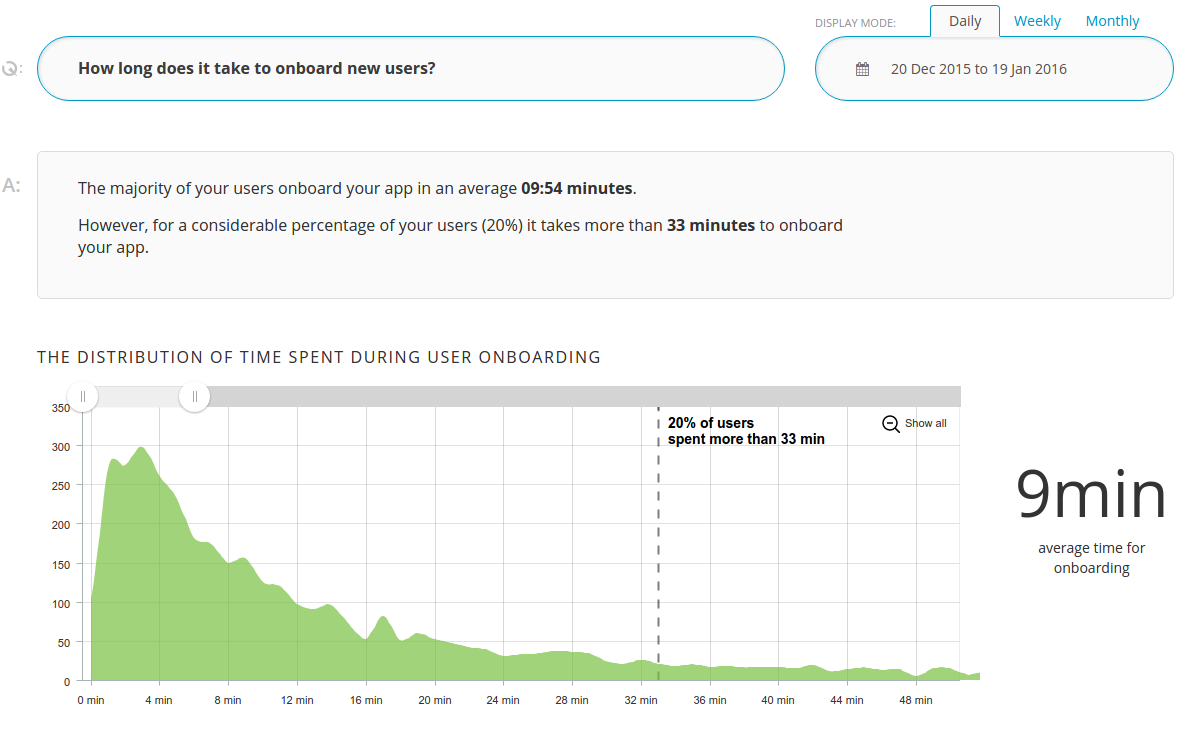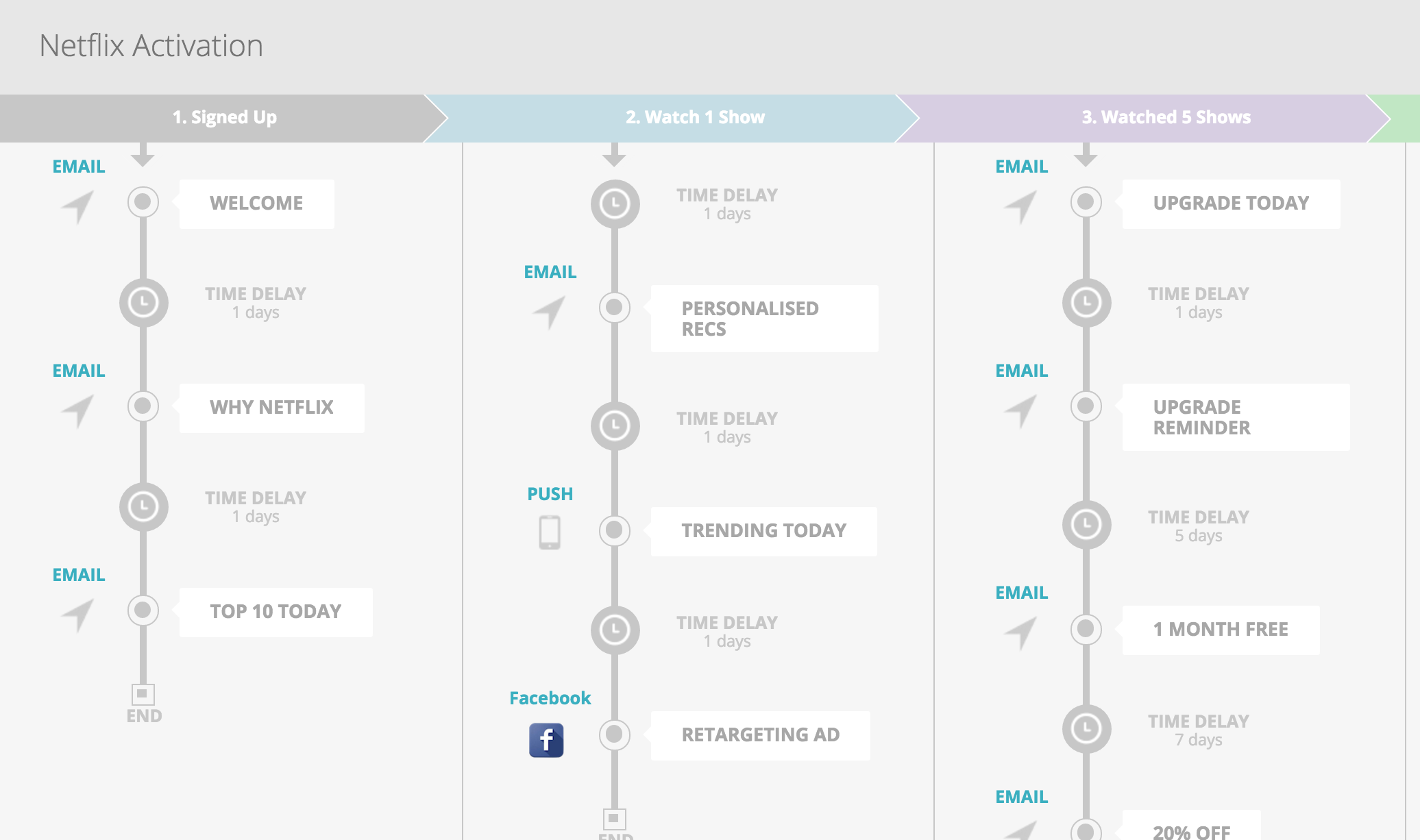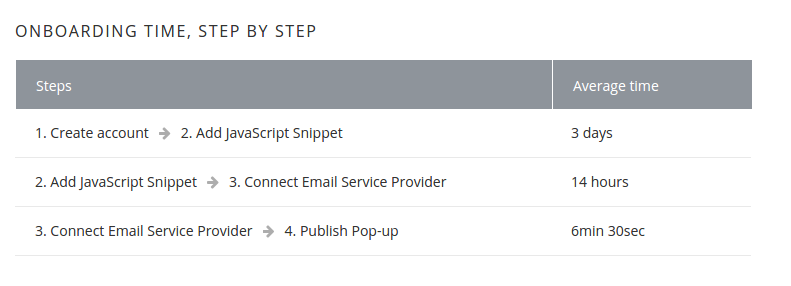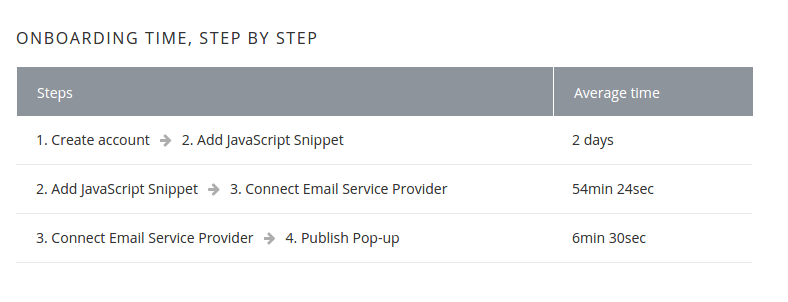B2B customer onboarding process involves friction even for the best optimized processes.
Things like connecting a social media service or adding a snippet of code on a website, can be a time consuming process, especially for larger companies.
The longer it takes to complete each step in your customer onboarding process, the lower your chances of fully onboarding a user.
Not only that but the user onboarding time has a direct impact on your bottom line.
What is your user onboarding time?
Giving an average answer to this question, for example, saying it takes around two hours, isn’t terribly helpful. If this is your average onboarding time, you need to know how many people are around it.
Questions to ask:
- What is the longest time it takes for users to become onboarded?
- What is the average onboarding time for the majority of users?
- What’s the tipping time point after which users take a lot of time?
Your B2B customer onboarding process probably has more than just one or two steps so it’s also very important to find out which steps delay user onboarding the most.
If you are to optimize the time users spend onboarding, those steps are your starting point.
Here is how InnerTrends reports on how long it takes to onboard new users:

Once you know your user onboarding time, how do you use it?
According to the above report, most people spent around 9 minutes onboarding while 20% of them spend more than 30 minutes.
By using the 30 minutes time reference you can start scheduling emails to help users who get stuck.
I like to use the escalating model, explained below by Peter Tanham:
We take an approach we call “escalating intensity” for when a user gets stuck at a certain step.
This means that the longer they’re stuck at a certain step, the more we intensify the communications we send to them.
So first they get a gentle reminder email. If they’re still here a day later we’ll try motivate them (remind them of the value proposition).
If they’re here another day later we’ll send “how to” messaging.
A week after sign up we might send a discount code for 10% off. Then add them to a social retargeting campaign to get them back. Then a 20% off code.
The idea is that each engagement will bring more and more users through that friction point and to the next step, so eventually you’ll only be messaging users who are very unlikely to complete onboarding of their own volition, so what have you got to lose with a discount offering?
You don’t want to go too heavy too soon or you’ll end up discounting (or just annoying) users who are being onboarded naturally by your product.
Peter was also kind enough to share with us an example that they often use. This is that it might look for a company like Netflix:

How do you optimize the onboarding time?
After you’ve identified those steps where users spend most time you’re ready to correlate that data with the drop off in the onboarding funnel.
If the steps that take the most time to complete are also the steps where users have a high drop off, it’s probable that, by optimizing that time, you will also decrease the drop off for that step.
This in turn will improve your onboarding conversion rate.
Here’s an example from PadiAct, an email leads collecting software, for whom I designed the onboarding process.
This is how long the onboarding process took for PadiAct:

There were two steps where the users were spending considerably more than the average time:
- add javascript snippet
- connect email service provider
These steps also had a high drop off.
The first was obvious because many companies can’t place code on a website in minutes.
We re-wrote the code to create a short version that allowed anyone who had some basic experience with Google Analytics to be able to implement it.
We also offered an FAQ and additional documentation that clarified every single action the users had to take so that they wouldn’t have any doubts about how the code needed to be added.
While the drop off decreased significantly for this step, the time it took was still averaging at a few days, compared with the other steps which could be completed in a couple of minutes.
The second step was a bit of a mystery to us. Why would it take such a long time for users to connect to an email service provider?
A few user interviews and support tickets later it turned out that some users, bigger companies especially, were very reluctant to give third parties any kind of access to their email lists.
They didn’t trust us enough to do it.
Because of this they could not fully test our service and decide if it was something they wanted.
Our solution? We decided to give them the option of collecting email leads directly into PadiAct, using a white label email service so we didn’t have to build it ourselves.
This allowed users to test PadiAct first, without connecting their email service provider.
Here are the results we got after the change:

What can we learn from this?
Without looking at the time needed to go from one step to the next and focusing only on the drop off, we might have gone in a completely different direction.
The focus would probably have been to improve the UX of the connection to email service providers or simply add more provider options.
None of these would have helped in onboarding larger companies because we were not addressing their actual problem.
Analysing the onboarding time report allowed us to consider other scenarios that weren’t on our radar otherwise.
The more friction there is during the onboarding, the longer the onboarding will take.
As long as the end of the onboarding is carefully planned out, the shorter onboarding time, in most cases, correlates with higher onboarding rates.
Looking for deep insights into how your customers use your product?
InnerTrends can help. You won’t have to be a data scientist to discover the best growth opportunities for your business, our software will take care of that for you.

Schedule a Demo with us and witness with your own eyes just how powerful InnerTrends can be.